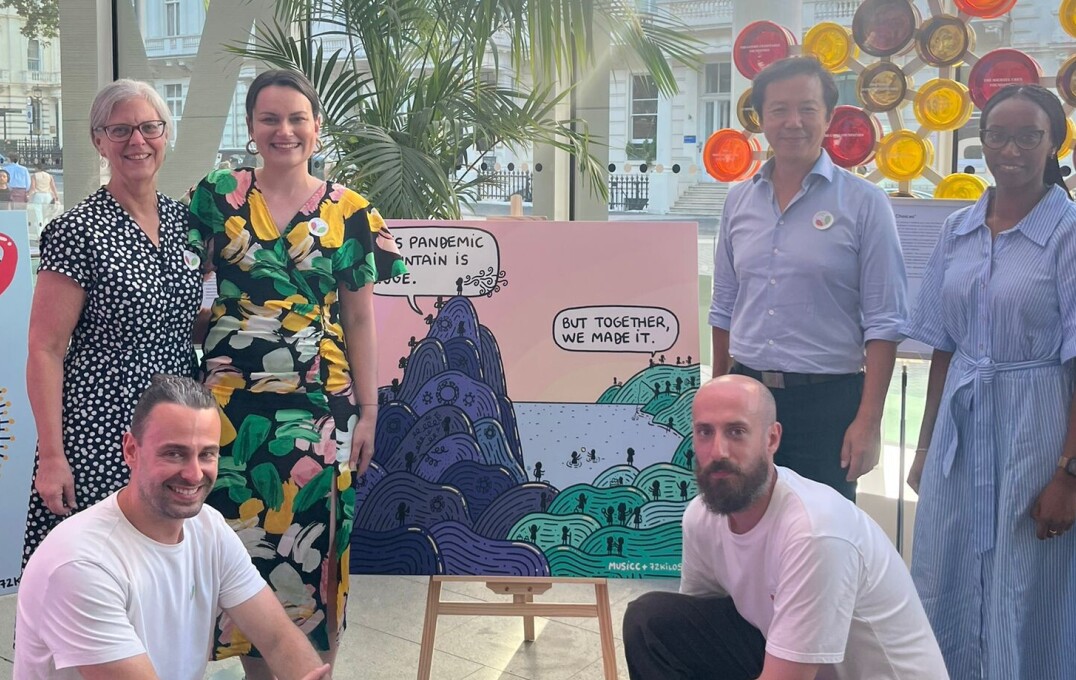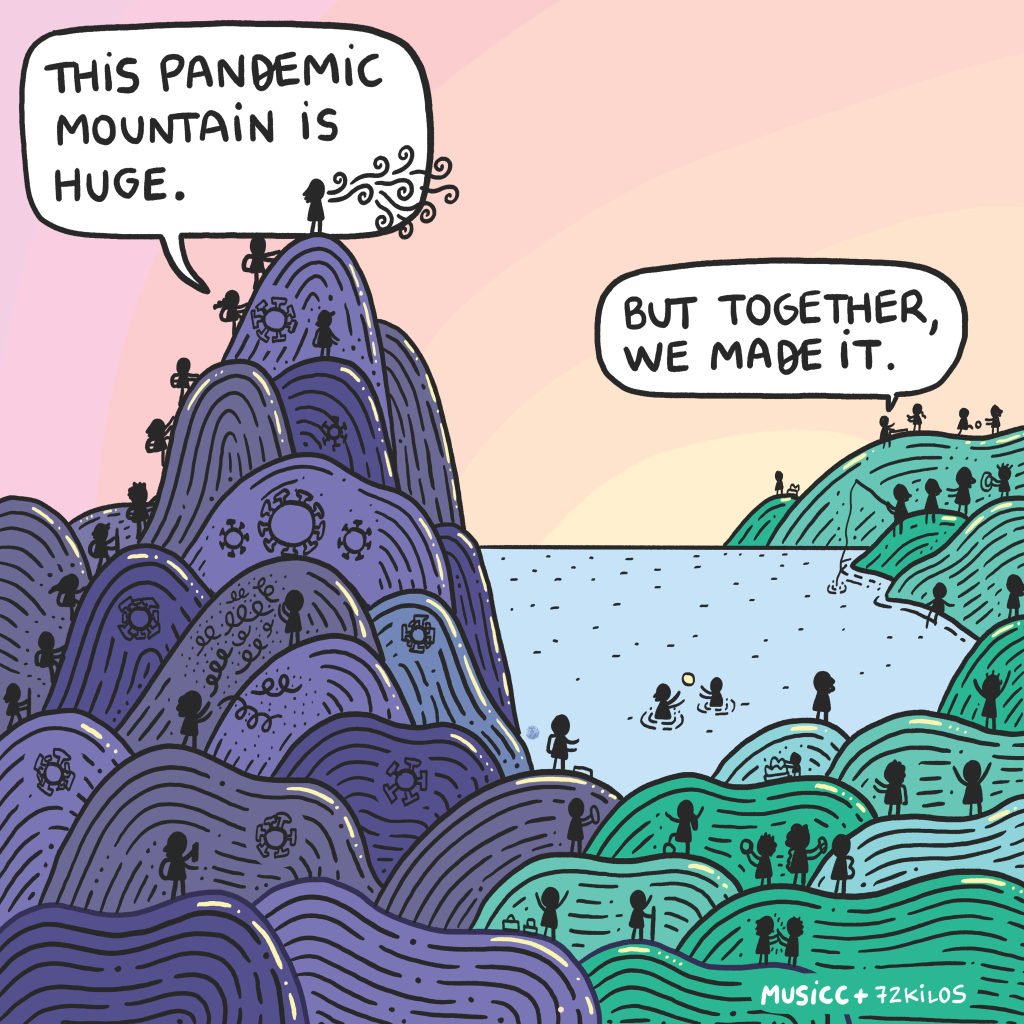
MUSICC has collaborated with artist 72kilos to create an inspiring vignette that speaks to the overall challenge and goal of the research project.
The artwork was unveiled, as part of a series, at an evening celebrating the work of the Research Impact Management Office (RIMO) at Imperial College London (Imperial), United Kingdom. RIMO is responsible for leading MUSICC’s project management and communications efforts within the project’s Coordination Team. The team has great expertise and experience in these areas, especially considering the depth of their portfolio on projects funded by the European Commission (EC).

Members of MUSICC’s coordination team (L-R) Kylie Glasgow, Mike Darkes, Marla Geibel, Ben Davis, Chris Chiu and Aminata Sy.
72kilos, aka Óscar Alonso, is an artist hailing from Spain and has amassed a following of almost 2.4 million followers on Instagram alone. Beginning in 2008, 72kilos’ vibrant and thought-provoking vignettes have captured the attention and imagination of many viewers. The power of 72kilos’ ability to express so much in such a single piece made for an exciting and novel way to communicate MUSICC. On working on the collaboration 72kilos said, “Working with the teams who approach science with patience, curiosity and a drive to find solutions to the big challenges in society has been amazing. I’m proud to have been part of this BIG project and the very people who made it all possible. More science, please!”.
Representing the scale and impact of the COVID-19 pandemic, ‘Over the Mountain’ by 72kilos polarises a world dealing with a pandemic to a world that has overcome one. Coughing figures adorn the dark pandemic world and gaze upon the vibrant post-pandemic landscape, as figures there celebrate, together. On the left of the image a group can be seen scaling the mountain together, representing the magnitude of the challenge, and the global collaboration required to overcome it.

‘Over the Mountain’ by 72kilos
Indeed, it is this level of collaboration that is key to MUSICC’s success. MUSICC is a five-year CEPI and EC co-funded project seeking to improve the world’s disease response and pandemic preparedness. Developing models for research studies and understanding immunity within the human respiratory tract, paves the way for MUSICC to develop the next generation of COVID-19 vaccines. Vaccines that aim to not only reduce the severity of symptoms but prevent infection entirely. In the next pandemic, this transmission prevention would enable us to reach the other side of the ‘mountain’ much quicker. This is no easy task and hence requires an international consortium of experts such as the MUSICC consortium.
Creating the optimal environment for collaboration is all part of RIMO’s ethos in ‘making research glow’. Helping researchers to ‘make it over the mountain’, as a part of MUSICC’s Project Coordination Team at Imperial, is RIMO’s own Marla Geibel. As Project Manager Marla recognises how pivotal such coordination be for MUSICC:
“In a project as ambitious and complex as MUSICC—with over 21 partners across the globe and a mission to transform how we prevent coronavirus transmission—my role as Project Manager is to ensure that collaboration thrives. I focus on aligning timelines, deliverables, and resources so that our researchers and partners can concentrate on the science. What makes this work especially rewarding is fostering a research culture where coordination isn’t just about logistics—it’s about creating the conditions for trust, clarity, and shared purpose to deliver impact-driven research.”

Project Manager Marla Geibel coordinating efforts at MUSICC’s first annual meeting
Coordinating so many partners requires a great deal of effort and so Marla is assisted in MUSICC’s project management by fellow RIMO member Ben Davis. Ben is no stranger to understanding the types of collaborative benefits his role can bring to MUSICC:
“Working with such a large consortium, our team aims to simplify processes to allow the teams to focus on the science, reducing the administrative workload. By funnelling the project’s funding requirements through our team, we are able to translate these into concise communications to research leads to maximise as much of their valuable time on the scientific outcomes of the project. A lot of our work is the parts of the project that go on behind the scenes, away from the science, that help to keep a project on track. A good example of this is that our team streamlines and keeps track of the project via various monitoring tools, to ensure project outputs and milestones are provided to the project funder within the specified timeframe – like a personal project management alarm clock!”

Assistant Project Manager Ben Davis presenting on project management progress
Collaboration between the project management and research teams is key to delivering the project goals, particularly through enabling researchers to focus on their scientific aims. But such relationships are not limited to research and project management.
An impactful research project also requires effective communication with its external stakeholders and audiences. As Communications Lead this is what I, Mike Darkes, focus my efforts on. A project of such magnitude requires the involvement of many external stakeholders including the general public, parallel research communities, regulators and policy makers.
Effective communication with these groups involves bringing them on the project’s journey. This ensures transparency and allows members of these groups to feel that this is something they can understand and be a part of, when such opportunities arise. Achieving this in MUSICC requires collaboration from members of all areas of the project, not just those with communications expertise.
As Communications Lead for MUSICC this is where collaboration is most vital for me. Working with the consortium’s researchers to celebrate and inform the world of their work, in an accurate and accessible way, is a key part of my role. But also collaborating with them and their institutional colleagues to identify and coordinate opportunities to discuss and engage on the work of MUSICC, outside of the project consortium.
Working with MUSICC’s range of external stakeholders in mind is a challenging prospect, but it is one our work with 72kilos speaks to well. The public make up a large part of this audience and their taxes pays towards this research. Therefore, we have a responsibility to ensure our communication is as informative and transparent as possible. Including the public as part of MUSICC’s journey is crucial, as we connect and discuss with them the very research intended to improve their public health and protection.
Public engagement is sometimes viewed as a one-way relationship, but at the heart of its effectiveness is a collaborative two-way discussion. So even in our relationships with our external stakeholders, collaboration is key. This does not mean the same approach can be taken for all of these groups. Our stakeholders and their needs are diverse, therefore so should be our outputs. But our team and collaborators are also diverse, and this is a strength we draw from.
At the heart of all these coordination and communication efforts is the research of MUSICC. Without the research there is no project to organise or talk about. The ambitiousness of MUSICC requires the wide range of expertise from the project’s consortium partners, based around the world. The work of each research team feeds into the next and requires knowledge and data to be shared throughout the consortium.
Such efforts were discussed recently as MUSICC partner NCID prepares to progress the project. This is directly represented in 72kilos artwork, as the team ascend the mountain and have to share information among each other, on the obstacles ahead and how best to navigate them. Through the involvement of the whole team, making it over the mountain becomes a much more likely scenario and the impact on the world beyond becomes that much brighter.
‘Over the mountain’ was recently on display at ‘Breathe: Speak Out’, a public engagement event around respiratory viruses in Leicester, led by MUSICC researcher Dr Daniel Pan. Sharing MUSICC’s communication outputs across the wider consortium is a key part of this collaborative effort, particularly in connecting with local communities in their area. Showing our stakeholders the mountain, is all a part of scaling it together.

‘Over the Mountain’ on display at ‘Breathe: Speak Out’ in Leicester

11th August 2025